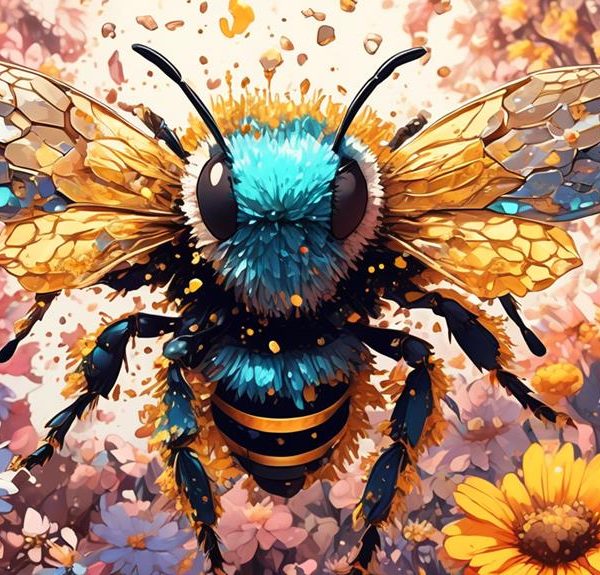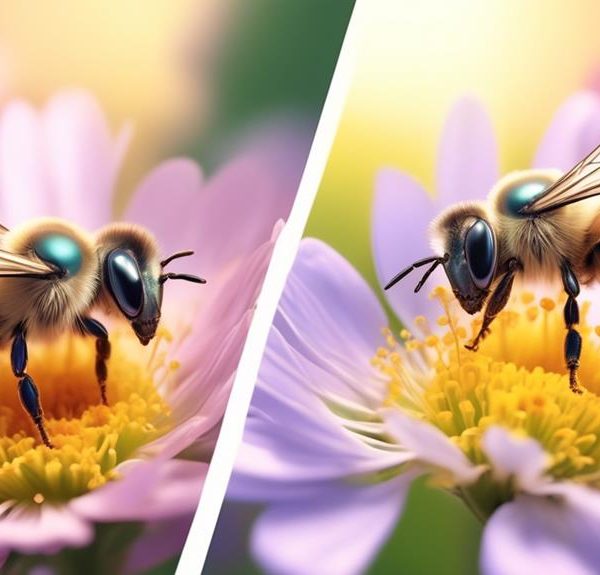Crack the mystery of mason and leaf cutter bees, as we delve into their distinct lifestyles, nesting habits, and roles in pollination.
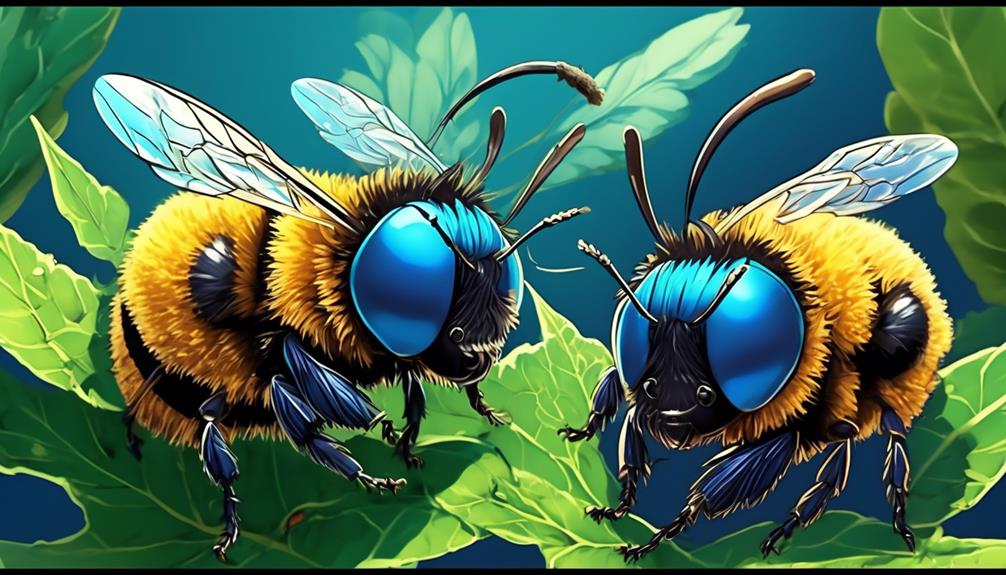
Are Mason Bees and Leaf Cutter Bees the Same
You've seen them buzzing in your garden, you've marveled at their industriousness, but you've likely puzzled over their identities. Are the mason bees the same as the leaf cutter bees? It's a common question, and understandably so, considering their similar sizes and shared penchant for solitary behavior.
However, the answer isn't as straightforward as you might think. There are subtle but distinct differences between these two species, in their life cycles, their nesting habits, and even their roles in pollination.
Ready to unravel this intriguing entomological enigma? Let's proceed, and you'll soon discover the fascinating world hidden within your very own backyard.
Key Takeaways
- Mason bees and leaf cutter bees are both solitary bees that do not live in hives.
- Mason bees nest in wood or masonry, while leaf cutter bees nest in established holes or carve out nests within solid plant material.
- Mason bees are more effective pollinators than honeybees and carry pollen all over their fuzzy abdomen, facilitating cross-pollination.
- Leaf cutter bees assist in pollination while cutting leaves for nests and pick up pollen grains on their hairy bodies to carry them to the next plant.
Understanding Mason Bees
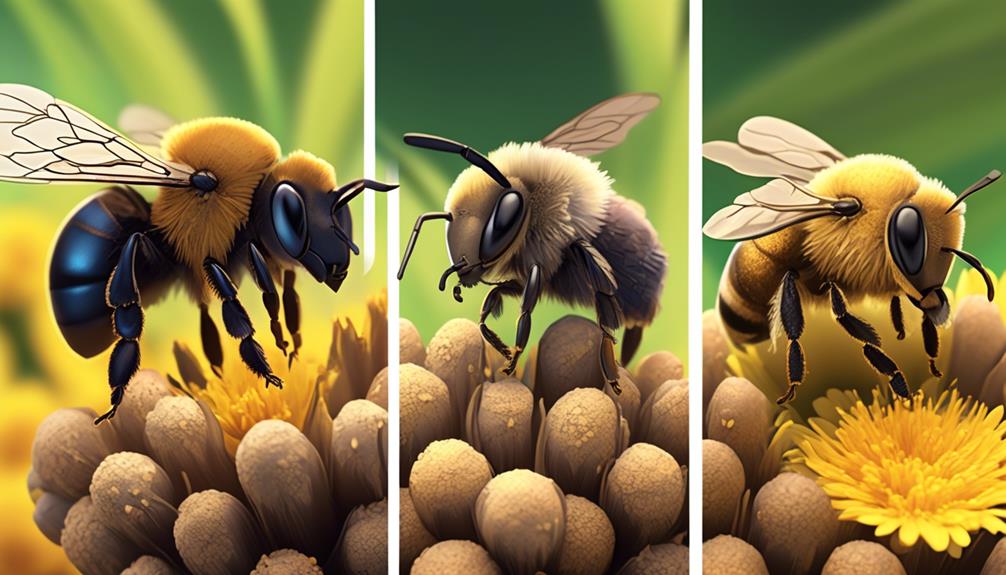
Often overlooked, Mason bees are fascinating creatures that you'll frequently find in your garden, playing a vital role in the ecosystem through their diligent and effective pollination habits. They're not your typical honeybees. They're solitary, meaning they don't live in hives. Instead, they nest in small crevices or holes, often in wood or masonry, hence their name.
Unlike honeybees, Mason bees don't produce honey or beeswax. Their primary purpose is pollination, and they're remarkably efficient at it. In fact, they're known to be more effective pollinators than honeybees. You see, when a Mason bee visits a flower, it collects pollen on its abdomen, where it's loosely held. This results in more direct contact with the flower's reproductive parts, leading to more effective pollination.
Interestingly, these bees are also less aggressive than other bee species. They'll only sting if they're threatened or squashed. This makes them a safe and beneficial addition to your garden.
Understanding these unique traits of Mason bees allows you to appreciate their role in maintaining the balance of nature. Remember, every creature, no matter how small, contributes to the ecosystem in its unique way.
Characteristics of Leaf Cutter Bees
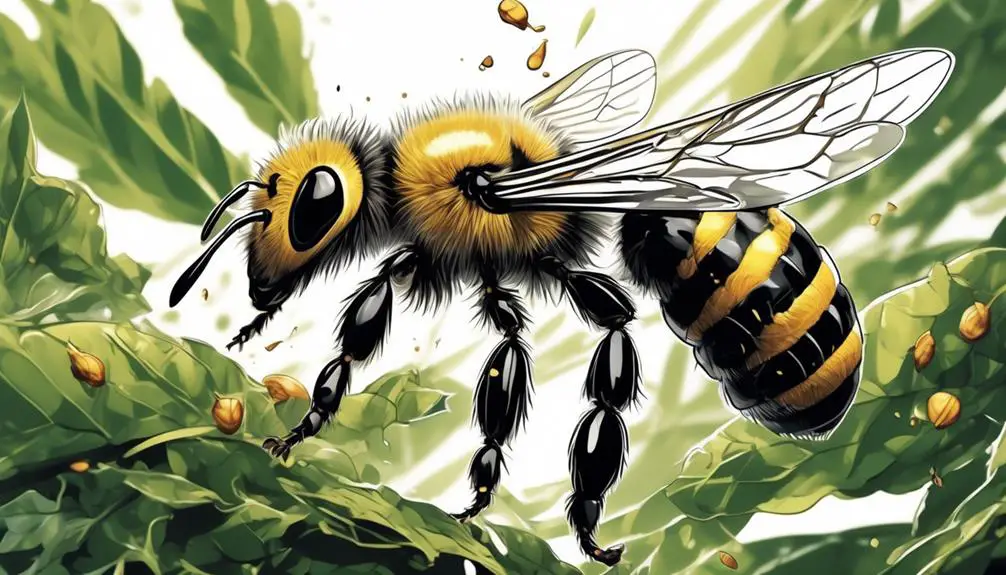
Just as Mason bees have their distinct characteristics, Leaf Cutter bees, another fascinating species, exhibit traits that are uniquely their own and contribute to the ecosystem in different ways. You'll find Leaf Cutter bees more solitary, making their nests in established holes rather than constructing their own. They're named for their intriguing behavior of cutting perfectly circular pieces from leaves to line their nests.
These bees are remarkable for their precision. When they cut leaves, they're able to make the cuts incredibly clean and precise, an astounding feat considering their small size. They don't cause significant damage to plants, as they only take what they need for their nesting material.
Leaf Cutter bees are also efficient pollinators, often more so than honeybees. They carry pollen on their abdomen rather than on their legs, allowing for more direct contact with the flowers. Their body shape also allows them to access different types of flowers, increasing their pollination range.
However, unlike Mason bees, which are primarily active in the spring, Leaf Cutter bees are most active in the summer. This difference in active periods allows for a broader range of plant pollination throughout the growing season.
Lifecycles: Mason Bees Vs Leaf Cutter Bees
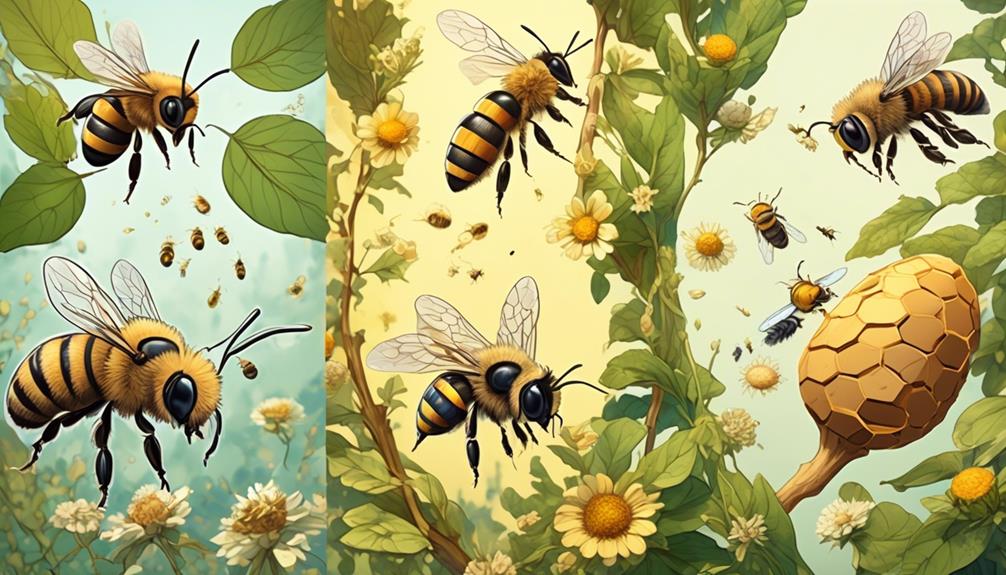
To fully appreciate the roles of Mason and Leaf Cutter bees in our ecosystem, you need to delve into their unique lifecycle patterns, which are as fascinating as they're diverse.
Mason bees are solitary insects with an annual lifecycle. They start as eggs laid in late spring, developing into larvae during the summer and then into pupae by late fall. They overwinter as adults in the very cocoons they were born, emerging in the spring to start the cycle anew.
Leaf Cutter bees, on the other hand, have a more variable lifecycle. They can produce multiple generations in a year, depending on climatic conditions. Their eggs are laid in nests lined with leaf fragments, where they develop into larvae, pupate, and finally emerge as adults. The timing of these stages can vary, with some bees overwintering as prepupae while others emerge as adults in the same year.
Analyzing these life cycles, it's clear that Mason bees have a more predictable, annual pattern while Leaf Cutter bees show more flexibility, allowing them to adapt to different environmental conditions.
Thus, while they share similarities, their lifecycles highlight the unique strategies that contribute to their survival and role in pollination.
Habitat and Nesting Differences
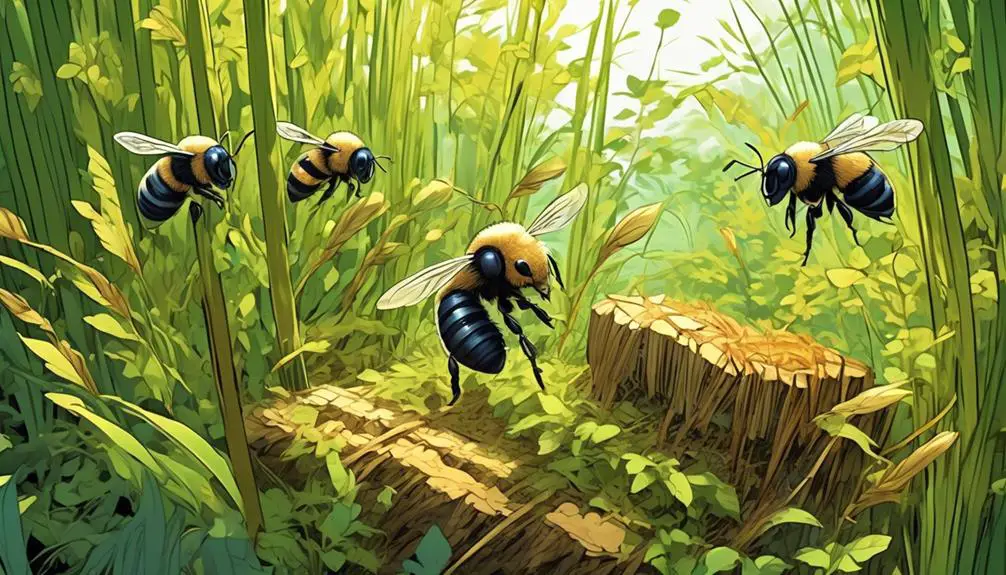
While examining their lifecycles has provided insights into their survival strategies, you can learn even more about Mason and Leaf Cutter bees by exploring their distinctive habitat preferences and nesting behaviors.
Mason bees, specifically, are solitary creatures and prefer to nest in pre-existing holes in wood or in the hollow stems of plants. They don't excavate their own nests but rather utilize what's readily available in their environment. They're often found in urban or suburban landscapes, making them an ideal neighbor for your garden.
On the other hand, Leaf Cutter bees display a different strategy. They carve out their nests within solid plant material, often selecting rose bushes or other thick-stemmed plants. They're less likely to be found in urban settings, favoring more natural, less disturbed environments.
These distinct habitat and nesting preferences highlight the adaptability of these species. Mason bees, with their utilization of pre-existing cavities, showcase an opportunistic survival strategy. Leaf Cutter bees, with their industrious carving, exhibit a more labor-intensive approach.
Both strategies, however, underscore the remarkable resilience and versatility of these often overlooked pollinators. Understanding these differences can help you support these essential creatures in your local ecosystem.
The Role in Pollination
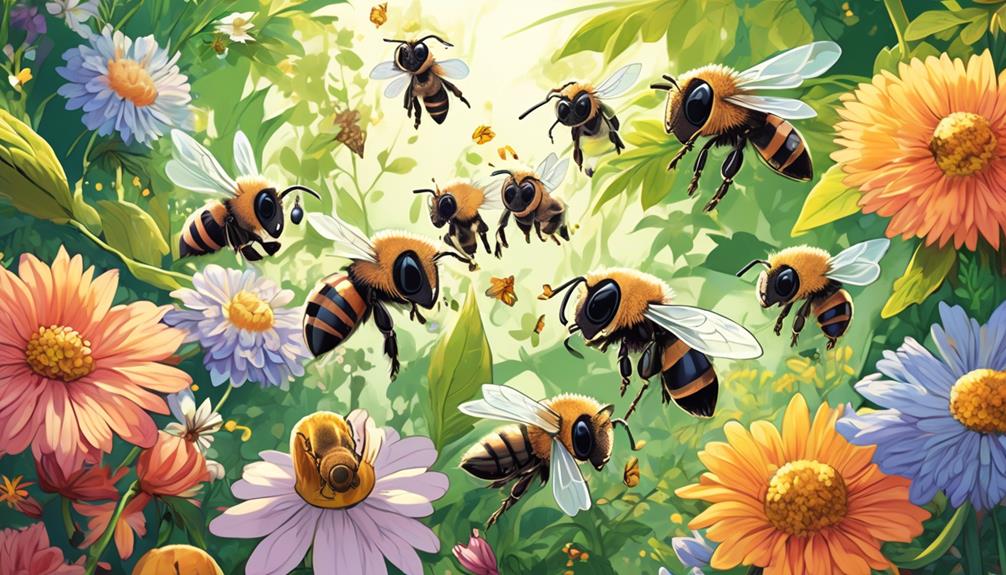
In the grand scheme of pollination, Mason and Leaf Cutter bees play a vital, yet often overlooked, role, ensuring the health and propagation of diverse plant species. Unlike their honeybee counterparts, who focus on nectar collection, these solitary bees prioritize pollen gathering.
Mason bees, for instance, are extremely efficient pollinators. Their bodies are designed to carry pollen, not just on their legs, but all over their fuzzy abdomen. When they're out and about, pollen sticks to their bodies and gets transported to other flowers, facilitating cross-pollination. A single mason bee can do the work of 100 honeybees!
Leaf Cutter bees, on the other hand, cut circular pieces from leaves not only to construct their nests but also to assist in pollination. While cutting, they inadvertently pick up pollen grains on their hairy bodies and carry them to the next plant.
Unraveling Common Misconceptions
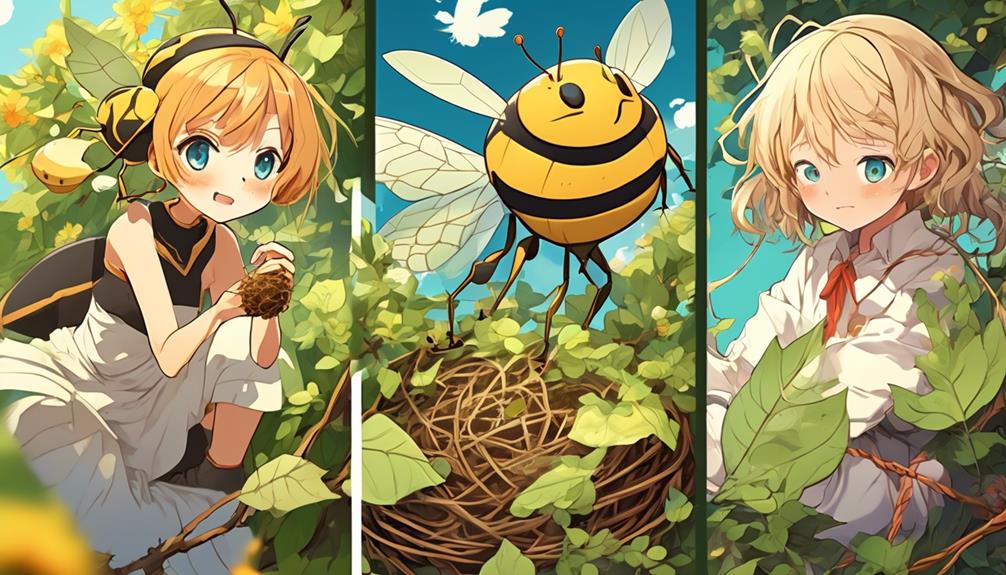
Despite the significant roles Mason and Leaf Cutter bees play in pollination, there's a swarm of misconceptions surrounding their nature and behavior that often leads to unnecessary fear and avoidance. Don't let misinformation guide your actions and attitudes towards these vital pollinators.
One common myth is that these bees are aggressive and pose a significant sting threat. In reality, both Mason and Leaf Cutter bees are docile creatures. They're less likely to sting than their honeybee counterparts, and when they do, it's far less severe.
Another misconception is that these bees are destructive to vegetation. Yes, Leaf Cutters do cut leaves, but they don't harm the plant's health or growth. Instead, they use these leaf fragments to construct their nests. Mason bees, on the other hand, don't damage plants at all.
Lastly, some believe all bees produce honey. This is incorrect. While honeybees are famous for their sweet product, Mason and Leaf Cutter bees don't produce honey. Their primary role is pollination, not honey production.
Frequently Asked Questions
What Predators Pose a Threat to Mason Bees and Leaf Cutter Bees?
No, Mason Bees and Leaf Cutter Bees aren't the same. They're both solitary bees but belong to different species.
As for predators, you've got birds, spiders, and wasps that can pose a threat to these bees. There's also the parasitic Tachinid fly that lays eggs in the bee larvae.
You've also got to watch out for fungus and bacteria which can infect and kill the bees.
It's a tough world out there for these little pollinators.
Are There Any Specific Diseases or Parasites That Affect Mason Bees and Leaf Cutter Bees?
No, Mason Bees and Leaf Cutter Bees aren't the same.
You'll find that Mason Bees are from the Osmia species and use mud or clay to seal their nests.
On the other hand, Leaf Cutter Bees, belonging to the Megachile species, use leaf pieces to construct their nests.
Each species has unique behaviors and preferred nesting materials, though they're both solitary and beneficial pollinators.
How Can One Differentiate Between a Mason Bee Sting and a Leaf Cutter Bee Sting?
You can't really differentiate between a Mason bee sting and a Leaf cutter bee sting. Both are solitary bees and rarely sting. If they do, it's usually because they're threatened. Their stings are less painful than a honeybee's, and you'd likely just feel minor discomfort.
What Are the Conservation Efforts in Place to Protect Mason Bees and Leaf Cutter Bees?
No, Mason Bees and Leaf Cutter Bees aren't the same. They're different species within the large bee family.
Mason Bees, named for their practice of using mud or clay to seal their nests, are excellent pollinators.
Leaf Cutter Bees, on the other hand, are known for cutting neat circles out of leaves for their nests.
Both are solitary bees, meaning they live and work alone rather than in colonies like honeybees or bumblebees.
How Does Climate Change Impact the Populations of Mason Bees and Leaf Cutter Bees?
No, Mason Bees and Leaf Cutter Bees aren't the same. They're different species of solitary bees.
Mason Bees are named for their practice of using mud or other 'masonry' products in nest building.
On the other hand, Leaf Cutter Bees are known for cutting circular pieces from leaves and using them to construct their nests.
They have different behaviors, habitat preferences, and physical characteristics.
Conclusion
In conclusion, while you might think mason bees and leaf cutter bees are the same, they're actually quite different.
From their physical characteristics to their lifecycles, habitats, and roles in pollination, these bees are unique.
It's important to dispel misconceptions and understand these differences, as both species play vital roles in our ecosystem.
So next time you spot a bee, pause and appreciate its individuality – it's quite possibly a hard-working mason or leaf cutter bee.

